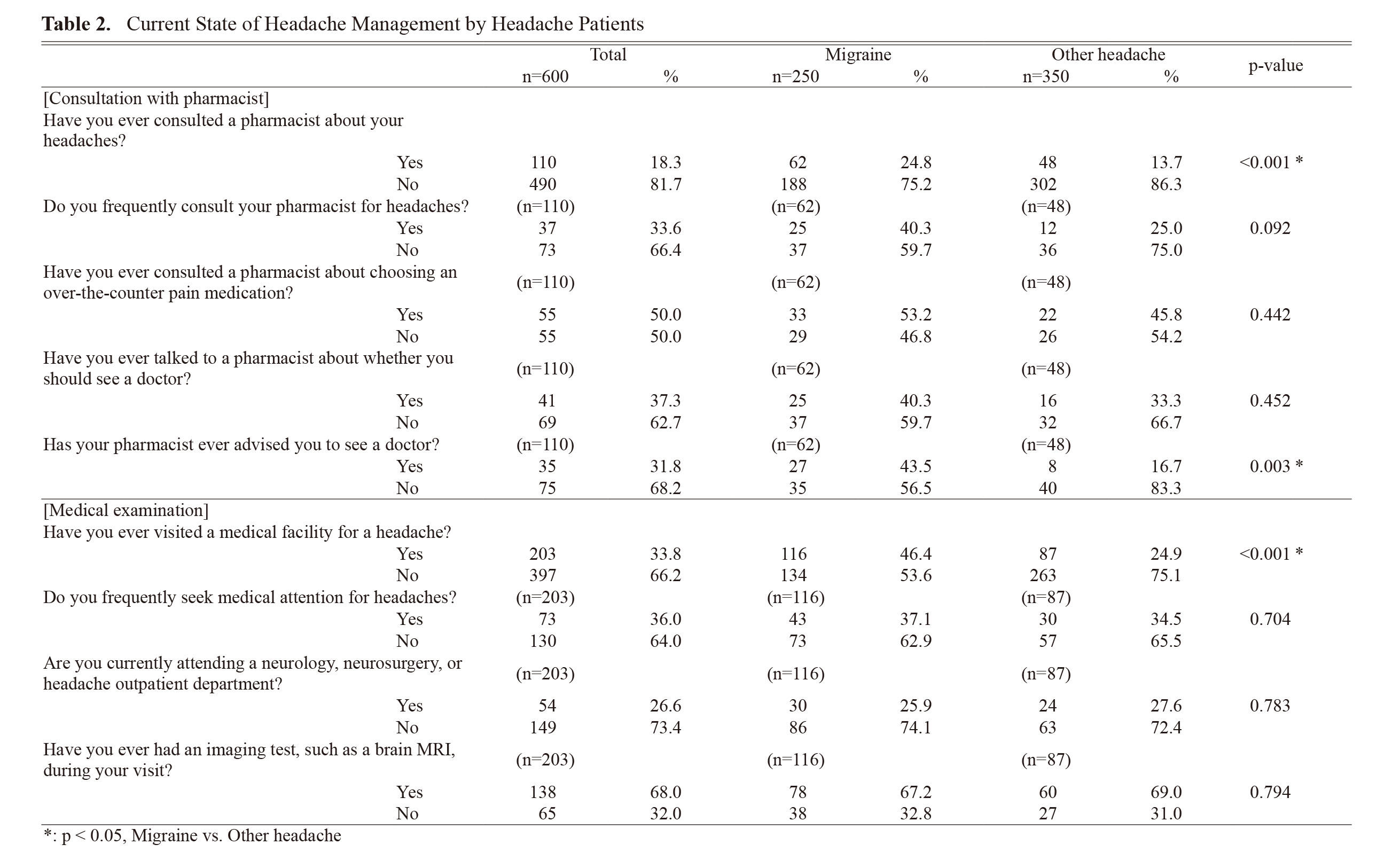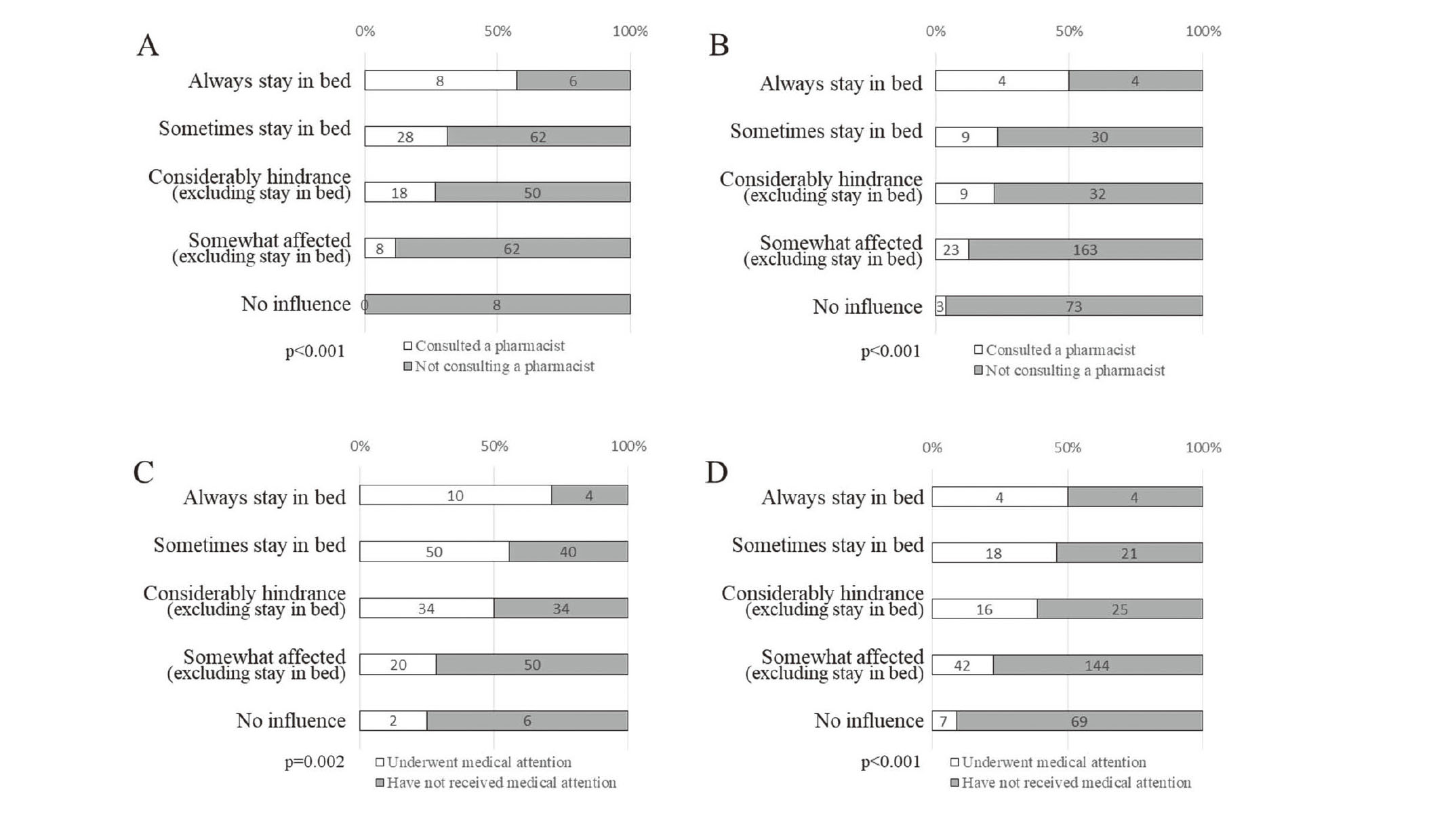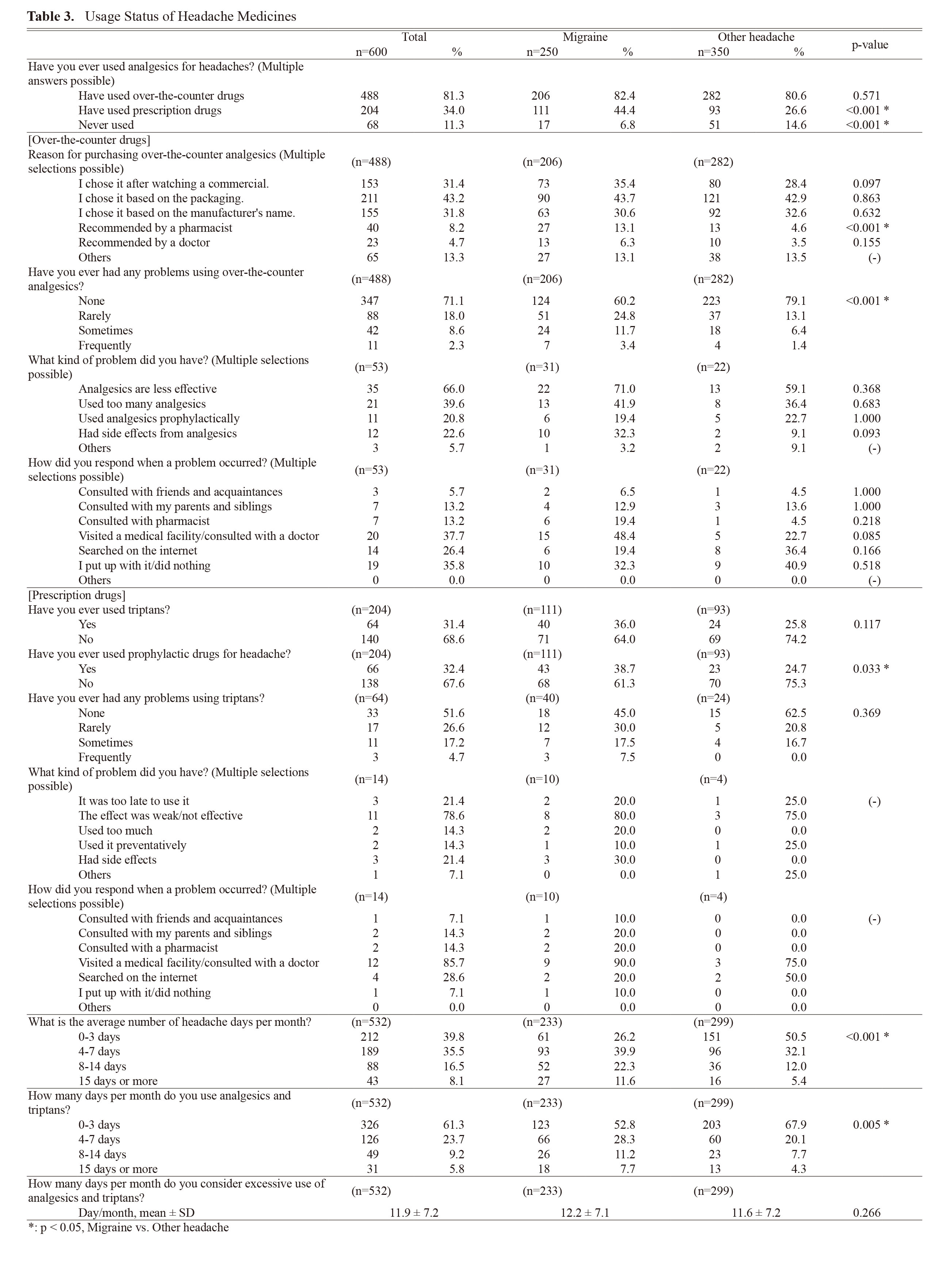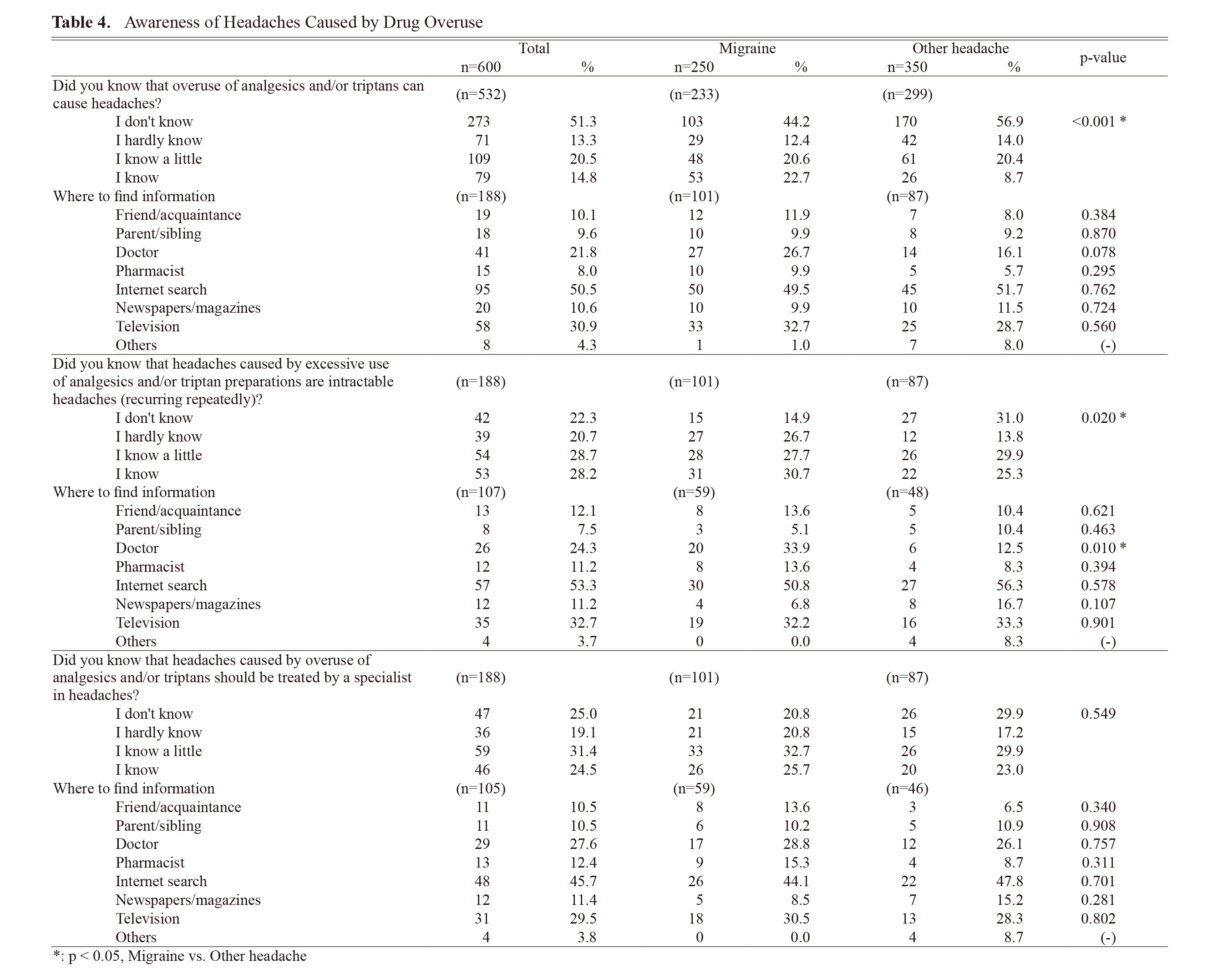2023 Volume 6 Issue 6 Pages 229-235
2023 Volume 6 Issue 6 Pages 229-235
To clarify the current status and challenges of pharmacist involvement in headache treatment, we conducted a questionnaire survey of people who were aware of having headaches. A questionnaire survey was conducted on the Internet of 600 subjects between the ages of 20 and 40 who had suffered from headaches in the past three months. Subjects were divided into a migraine (n = 250, 55.2% women) and other headache (n = 350, 46.3% women) groups. The degree of interference with daily life was higher in the migraine group than in the other headache group. Regarding headache consultations with pharmacists, many people in the migraine group had not consulted a pharmacist even when the severity was high; however, 43.5% of those who had consulted a pharmacist had been recommended to see a doctor. Regarding the status of medical visits, approximately half of the migraine group did not visit a doctor even when the degree of disability was high, and only 44.4% of the migraine group were treated with prescription drugs. Regarding the level of awareness of headaches caused by overuse of analgesics, the majority of respondents in both groups answered “I don't know” or “I hardly know.” Since many people with headache are treated with over-the-counter (OTC) drugs, pharmacists are required to follow up with those who are treating their headaches with OTC drugs, and to recommend treatment with prescription drugs if their headaches are interfering with their daily lives.
Among chronic headaches, migraine is a common neurological disorder, which is typically characterized by severe pain on one or both sides of the head and disturbances in vision.1) Headache symptoms, such as restrictions on activities in daily life, persistent discomfort, and decreased concentration, place a burden on people's lives.1) Accordingly, many patients rely on over-the-counter (OTC) drugs for the treatment of symptoms.2,3) According to the OverCOME study, only 57.4% of people with migraine visited a medical facility, 14.8% were currently using triptan preparations, and 9.2% were currently using prophylactic drugs.3) Therefore, the role of pharmacists who sell OTC drugs for headache treatment is extremely important from the perspective of increasing the rate of medical examinations for migraine patients.
Among chronic headaches, medication overuse headaches (MOH) are often associated with migraine patients. MOH is an intractable headache that is triggered when analgesics are taken in excess.4) Treatment for MOH at a headache outpatient clinic, neurology, neurosurgery, or pain clinic that specializes in headaches requires that the treatment and guidance be tailored to each patient's progress. Many cases of MOH in Japan are caused by OTC analgesics;5) therefore, it is necessary for pharmacists in pharmacies to make an assessment of whether the headache patient has MOH based on their symptoms and complaints, when selling OTC analgesics.
A Tracing Report (TR)6) is a document that conveys information collected from patients. TR is considered important in terms of the effectiveness and safety of drug therapy. For pharmacists, “shifting from dealing with materials to dealing with people,” and collaboration between pharmacies and medical facilities is becoming more important. Thus, the use of TRs is attracting attention as an information provision and collaboration tool. With the advent of TRs, it has become possible to follow up patients being treated with prescription drugs through medical collaboration. However, there is no way to coordinate medical care to monitor patients who are being treated with OTC drugs for headaches.
In this study, we conducted a questionnaire survey of people who were aware of their headaches in order to clarify the current state of headache treatment and the involvement of pharmacists in headache treatment.
We used Cross Marketing Inc., an Internet research company, to recruit subjects. The subjects were in their 20s to 40s and had headaches in the past 3 months. The Internet research company sent questionnaire request emails to registered monitors (9,129 people), and 995 people responded to the screening. In this survey, we enrolled 600 subjects in their 20s to 40s, and the number of subjects in each age group was set to 100 for each sex. The response request email was sent on July 14, 2023, and the survey was discontinued on July 18, 2023, when the planned number of responses was reached. As a result, 600 samples were collected. The questionnaire was multiple-choice and anonymous to protect the personal information of the respondents. In addition to the basic attributes, the question items were "characteristics of headache", "current state of headache management", "usage status of headache drugs", and "awareness of headaches caused by drug overuse". This survey was conducted after obtaining approval from the Human Subject Research Ethics Committee of Teikyo Heisei University (approval number: 2023-012).
How to Differentiate HeadachesTo select people with migraine, we used the modified ID migraine screener Japanese version,7) which included five items: headache exacerbation during daily activities, nausea, photophobia, osmophobia, and phonophobia, during the past 1 year. Based on a previous study by Lipton et al.,8) we assessed the five items using the following criteria: “yes” was assigned to either a response of “less than half the time” or “half the time or more”, depending on the phrasing of the question. Participants who answered yes to at least two of five questions were considered to have migraines. Of the people who had headaches in the past 1 year, those who did not meet the criteria of migraines were considered to have other headaches. Moreover, people with migraines who answered yes to the question about aura symptoms (visual symptom) were considered to have migraines with aura. Migraines were evaluated according to the International Classification of Headache Disorders, Third Edition.9)
Statistical AnalysisData are expressed as mean ± standard deviation (SD) or number of respondents (%). In this study, the subjects were classified into migraine and other headache groups, and statistical analyses were conducted with Student’s t test for continuous variables, and χ2 test or Fisher's exact test for categorical variables. Fisher's exact test was utilized since the sample size is small with an expected frequency of less than five in one cell. In addition, some data were compared in sub-analyses based on whether patients consulted a pharmacist or received a medical examination. P < 0.05 was considered significant. If there was no relevant person or if statistical analysis was not performed, it was written as (-). The statistical software used was Excel Statistics ver. 3.21 (Social Information Service).
Of 600 subjects, 250 were divided into the migraine group and 350 into the other headache group. The proportion of women was 55.2% and 46.3%, respectively (p = 0.031, Table 1). The migraine group was divided into migraines with aura (73 people, 29.2%) and migraines without aura (177 people, 70.8%) based on the presence or absence of visual aura. Regarding the degree of interference with daily life during headache attacks, the migraine group had a biased distribution towards those with higher degree of interference compared to the other headache group (p < 0.001).
 Current Status of Approaches to Headache Treatment of People with Headache
Current Status of Approaches to Headache Treatment of People with Headache
When asked whether they had ever consulted a pharmacist about their headaches, 62 people (24.8%) in the migraine group and 48 people (13.7%) in the other headache group answered “yes” (p < 0.001, Table 2). Of those who answered that they had consulted a pharmacist about their headaches at least once in the past, 27 people (43.5%) in the migraine group and eight people (16.7%) in the other headache group were recommended to see a doctor (p = 0.003). Furthermore, we investigated the relationship between the impact of headache attacks on daily life and headache consultations with pharmacists, we found that many people had no experience of consulting with a pharmacist, even when they had a high degree of severity (Fig. 1A, 1B).


Relationship Among the Impact of Headaches on Daily Life, Consultation with a Pharmacist, and Medical Examination
The relationship between the impact of headaches on daily life and consultation with a pharmacist in the migraine (A) and other headache (B) groups. Comparisons were made based on whether patients consulted a pharmacist or not (A, B). The relationship between the impact of headaches on daily life and medical examination in the migraine (C) and other headache (D) groups. Comparisons were made based on whether the patients underwent medical attention or not (C, D).
When asked whether they had ever visited a medical facility for a headache, 116 people (46.4%) in the migraine group and 87 people (24.9%) in the other headache group answered “yes” (p < 0.001). Furthermore, when we compared the influence on daily life during a headache attack based on whether they visited a medical facility, approximately half of the people with headache did not visit a medical facility, even when they had a high degree of severity (Fig. 1C, 1D).
Usage Status of Analgesics for HeadachesWhen asked whether they had ever used analgesics for headaches, in the migraine group and other headache group, 206 people (82.4%) and 282 people (80.6%) had used OTC drugs; 111 (44.4%) and 93 (26.6%, p < 0.001) had used prescription drugs; and 17 (6.8%) and 51 (14.6%, p < 0.001), respectively, had never used drugs for headache treatment (Table 3).

When people who had used OTC drugs were asked why they purchased an analgesic, the most common answer in both groups was “I chose it based on the packaging”. In addition, 27 people (13.1%) in the migraine group and 13 people (4.6%) in the other headache group answered that it was “recommended by a pharmacist” (p < 0.001). Next, when asked if they had ever had any problems using OTC analgesic drugs, 124 people (60.2%) in the migraine group and 223 people (79.1%) in the other headache group answered “no”, but those who had experienced problems were significantly more likely to be in the migraine group (p < 0.001). Regarding problems caused by the use of analgesics, the most common answer given by 22 people (71.0%) in the migraine group and 13 people (59.1%) in other headache group was that “analgesics are less effective”. Thirteen people (41.9%) in the migraine group and eight people (36.4%) in the other headache group answered that they “used too many analgesics”. Next, when asked how they responded when a problem occurred, 15 people (48.4%) in the migraine group and five people (22.7%) in the other headache group answered: “I visited a medical facility/consulted with a doctor”.
When people who had used prescription drugs were asked whether they had ever used triptans, 40 (36.0%) in the migraine group and 24 (25.8%) in the other headache group answered “yes” (Table 3). Moreover, when asked whether they had ever used prophylactic drugs, 43 (38.7%) in the migraine group and 23 (24.7%) in the other headache group answered “yes” (p < 0.033).
When people who had used OTC or prescription drugs were asked about the average number of headache days per month, the distribution was more skewed toward those with more headaches in the migraine group than in the other headache group (p < 0.001). Furthermore, the distribution of the number of days of use of analgesics and triptan preparations per month was biased toward the migraine group, which used them for more days than the other headache group (p = 0.005). Additionally, when asked how many days per month they considered excessive use of analgesics and triptans, the response was 12.2 ± 7.1 in the migraine group and 11.6 ± 7.2 in the other headache group.
Awareness of Headaches Caused by Drug OveruseWhen we asked people who had used OTC or prescription drugs whether they knew that excessive use of analgesics or triptans could cause headaches, the majority of both groups answered: “I don't know” or “I hardly know” (p < 0.001, Table 4). Next, we asked those who answered “I know a little” or “I know” to the above question whether they were aware that headaches caused by excessive use of analgesics or triptans are intractable headaches (recurring repeatedly) and that they need to be treated by a headache specialist, 41.6% in the migraine group and 47.1% in the other headache group answered “I don't know” or “I hardly know”. When asked about sources of information, the most common answer was “internet search”.

In our study, in the migraine group, migraine with aura accounted for 29.2%, which is similar to that in a previous study in Japan1). Both headaches and accompanying symptoms are reported to affect the quality of life of migraine patients.1,2) Accompanying symptoms, such as headache exacerbation during daily activities, nausea, photophobia, osmophobia, and phonophobia, are more common in people with migraines than those with other headaches. We confirmed that the migraine group had a higher degree of disability in daily life than the other headache group. Although there is a possibility that people with migraines were included in the other headache group because physicians did not conduct interviews or diagnoses,10) people with migraines in this study had the characteristics of general migraine patients. However, this study limited the age of the subjects to those in their 20s to 40s and was conducted over the Internet; thus, there may have been bias.
Current Status of Headache TreatmentOnly 46.4% of people with migraines had visited a medical facility for treatment. We found that even though many people with migraines had problems in their daily lives, very few were using triptan or prophylactic drugs, which supports the findings of the OVERCOME study.3) Currently, in addition to triptan preparations, lasmiditan, a 5-HT1F receptor agonist, is available as an acute treatment for migraines, increasing treatment options. Regarding prophylactic drugs, CGRP-related peptides have been approved, and have achieved good treatment results.
Many people with headaches had used OTC analgesics for headache treatment, which supports the findings of previous studies.2,3) However, only 24.8% in the migraine group consulted a pharmacist about their headaches. If chronic headache patients continue to use OTC analgesics, there is a risk of MOH complications.5) Furthermore, there are concerns that the easy sale of OTC analgesics by pharmacists may lead to an increase in the number of MOH patients and worsening of symptoms. Because migraines are particularly susceptible to comorbidity with MOH,5) pharmacists need to distinguish migraine patients from chronic headache patients. The basic treatment for MOH is discontinuation of the causative drug; however, many patients eventually take OTC analgesics due to fear of pain. Treatment for MOH requires treatment tailored to each patient and using preventive medications for headaches under the supervision of a headache specialist. Furthermore, since many people obtain information about headaches on the Internet, it is important for pharmaceutical companies and academic societies to disseminate information.
An important finding of this study was that among those in the migraine group who had consulted a pharmacist about their headaches, 43.5% were recommended to see a doctor. We previously reported that only verbally recommending that a patient sees a doctor by a pharmacist is ineffective, few pharmacists made written recommendations to encourage patients to see a doctor, and patient information was not shared with doctors.11) For patients treated with prescription drugs, it has become possible for doctors and pharmacists to work together to follow up patients using TR.6) For patients receiving treatment with OTC drugs, it is necessary to establish a follow-up system in which doctors and pharmacists work together using medication notebooks and referral letters issued by pharmacists.
We thank Keisuke Maeda, a student at Teikyo Heisei University, for his technical assistance. This study was supported by a grant (Grant-in-Aid for Scientific Research (C), 21K06693) from the Ministry of Education, Culture, Sports, Science and Technology. The authors would like to thank Medical English Service (https://www.med-english.com/) for the English language review.
Conflict of interestThe authors declare no conflict of interest.